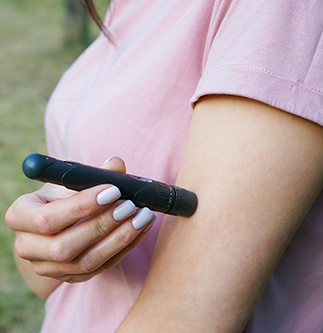
We’re heading into the summer, and after a long Canadian winter, many of us are more than ready to head outdoors. But the summer season also means some different planning when managing type 1 diabetes (T1D).
Please find below some tips and suggestions to help you get the most out of the sunny days.
COVID-19 Safety
Each province and territory has its own COVID-19 safety and re-start plans in place. Please check your province or territory’s health authority website for information on gathering sizes, indoors vs. outdoors, patios and other recreational amenities.
5 tips for managing T1D in the summer
- Stay hydrated. Hot weather can quickly dehydrate anyone. To prevent blood-sugar spikes from dehydration, drink water throughout the day.
- Test blood-sugar levels frequently. Hot temps can cause unpredictable swings in blood-sugar levels.
- Protect your gear. Keep your pump covered and your insulin cool. Heat can make insulin less effective and can cause pumps to malfunction. There are cooling cases specifically for insulin that can help you manage your supply.
- Pack snacks. Before any summer road trips or outings, be sure to stock up with snacks to help prevent blood-sugar lows. And try as best you can to stay on your food schedule.
- Exercise in the mornings or at night and plan any outdoor exercise for the cooler parts of the day. Exercising in the heat can cause heat exhaustion and make staying in a healthy range difficult. Be aware of how much you’re sweating. Too much moisture can damage some pumps, so make sure to check it while working out.

It’s also really important to wear sunscreen. Everyone should be protecting their skin from harmful UV rays, but with T1D, the need to wear sunscreen is extra important. Sunburns are a stress on the body and can cause blood-sugar spikes. Use SPF 30 or higher.
The Science of Summer
Heat can cause both unanticipated highs and lows in blood-sugar levels. As well, dehydration is common in the summer and can lead to blood sugar spikes as the glucose gets more concentrated in the bloodstream due to decreased blood flow in the kidneys.
The heat can also cause blood-glucose lows. As the temperature rises, the body’s blood vessels dilate, speeding up insulin absorption and increasing the risk of hypoglycemia. This is especially true while exercising, as working out already increases blood flow.
It’s essential to stay hydrated and find shade or go inside for a break when you feel overheated.
Summer Travel Checklist

Summers are made for getting away! If you’re planning on a day trip, or a longer excursion to a cottage or beach house, here are some things to consider taking with you:
- A travel letter from your doctor with written approval to travel with insulin and syringes (recommended)
- Insulin (and syringes or pens, depending on what you use)
- Test strips
- Lancets
- Ketone test strips
- Back-up snacks
- Emergency glucagon
- Supplies for any diabetes devices you use, for e.g. blood glucose meters, continuous glucose monitors (CGM) Flash GMs, or insulin pumps
- Pack twice as much medication and supplies as you think you’ll need (just in case!).
If you’re using an insulin pump, many manufacturers offer loaners for travel. Consider asking for one as a back-up.
If you’re flying, keep all of the above, especially your insulin, in a carry-on bag. Medications should be kept in a clear plastic bag, ready for airport security. Don’t store insulin or a CGM/Flash GM in checked luggage as the cargo holds can have extreme temperatures and could damage them before you land.
How to safely drink with T1D
T1D should not keep you from enjoying a margarita or frosty mug of beer.
Be mindful of your alcohol consumption, especially in the sun, as it can affect your body’s ability to regulate temperature. In general, stick to low-sugar options, stay hydrated (with water!) and don’t drink on an empty stomach.
For more information on alcohol and T1D: https://breakthrought1d.ca/alcohol-t1d/
With a little extra planning, you can make the most of the summer and the delights that it brings.
